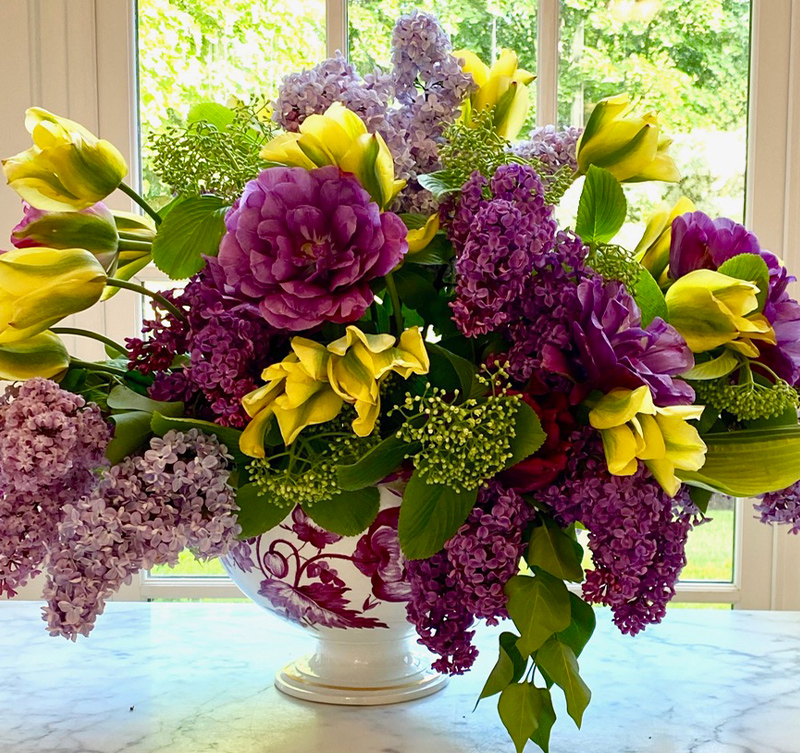
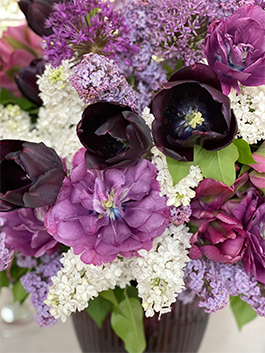
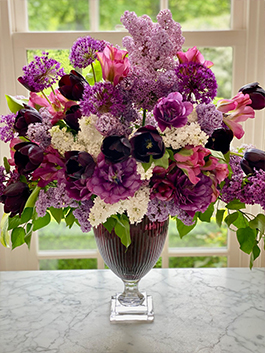
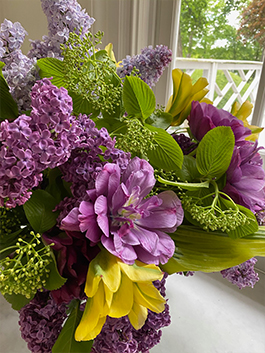
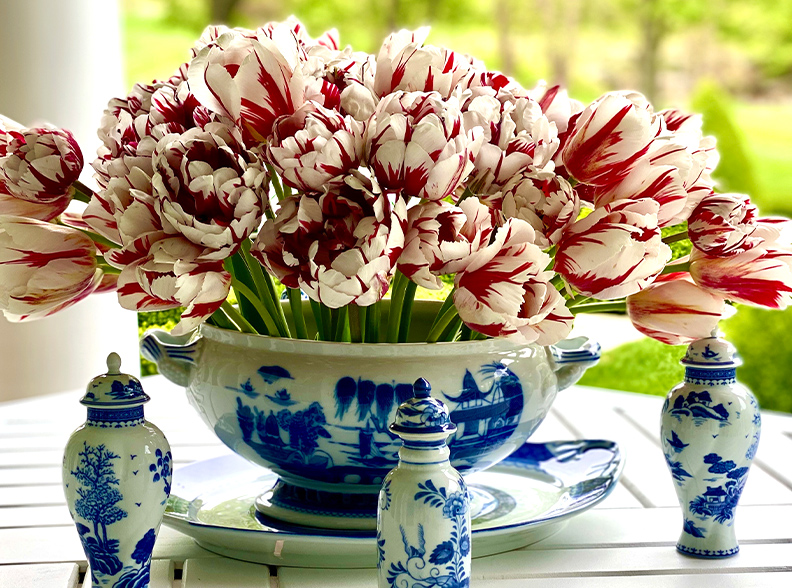
When I was a little girl, I loved to draw all day long! As children often do, I returned to the same theme time and time again – the clouds and the sun, a simple house, a stick figure child with her dog and three tulips growing on the side of the house. Those simple shapes and their ease appealed to my budding artistic eye and they were a comfort to me. A version of this drawing went on for years in my artwork (my mom even saved a few for posterity…HA!) and it always included my beloved tulips (perhaps this was the beginning of my tulip fever!).
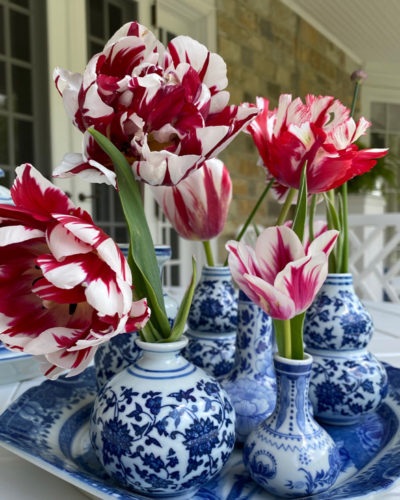
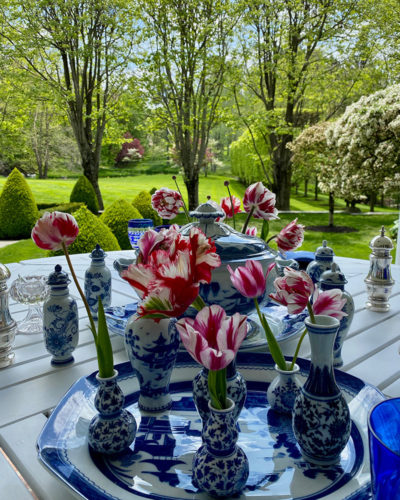
Fast forward to adulthood and they are still an absolute favorite flower of mine! An image of a single tulip I photographed graces the cover of my book, Flowers (and is the longest chapter in that book as well!). I return to them often as subjects to paint because of their visual complexity, elegance, movement and versatility. I was even given the opportunity to paint a label for a high-end wine produced by a friend and what did I choose? A tulip, of course! What better way to honor the long, graceful lines of the wine bottle than with this lithe counterpart.
This project appealed to me visually, as well as on a taste level. This rare and refined 2010 Fumanelli Amarone “Carolyne Roehm” is available at vinporter.com. This was the idea of our gracious friend, Armando Fumanelli, owner of the family winery Marchesi Fumanelli, who intended this to be a wine shared on very special occasions with loved ones.
When I first moved to Connecticut, I was so excited to plant my first bed of tulips. Little did I realize, the 300 bulbs I initially planted were barely enough to make a visual impact! Another lesson I learned (the hard way, I might add) is to plant them in a protected spot. Just as my first tulips were about to bloom, the dreaded deer ravaged their heads as a snack. I was devastated (and I learned to embrace the daffodils, which the deer don’t really like!).
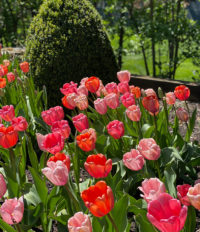
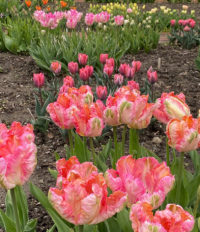
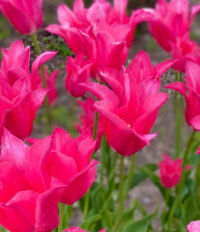
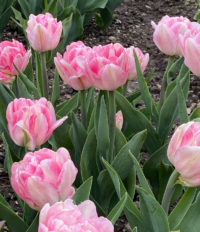
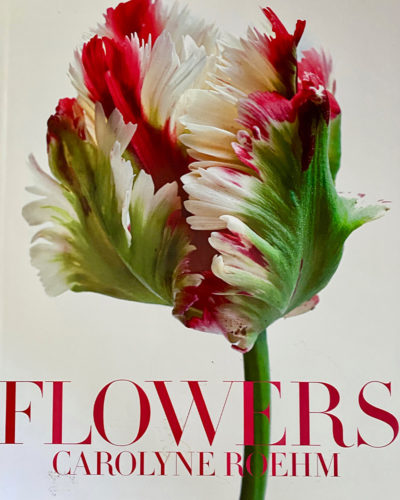
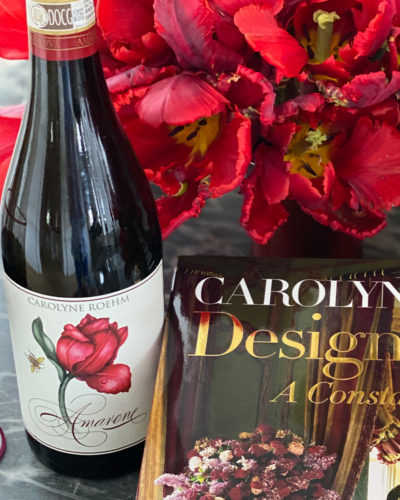
As I delved into the world of choosing tulips, the simplicity of my hand-drawn tulips were quickly replaced with an enormous world of possibilities. Now the varieties are vast and dynamic and there is amazing range in color, shape and texture. With their painterly strokes of captivating color, their fringes and their layers, they have emerged as one of the most diverse of flowers. I once called tulips the “graphic arts of the flower world” for their boldness in color and varieties in form. A vase full of vibrant, robust peony tulips is as close to perfection as I can imagine.
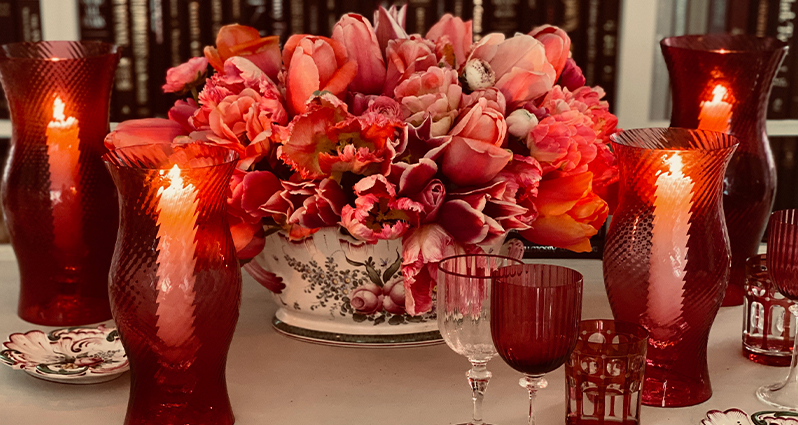
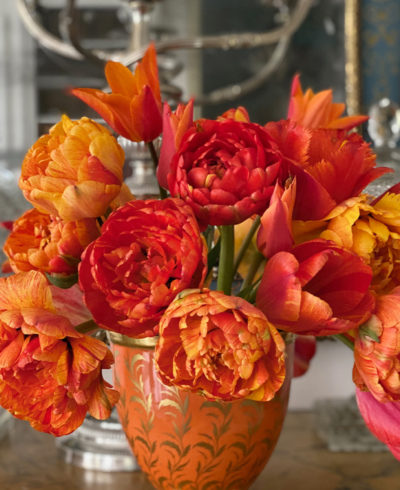
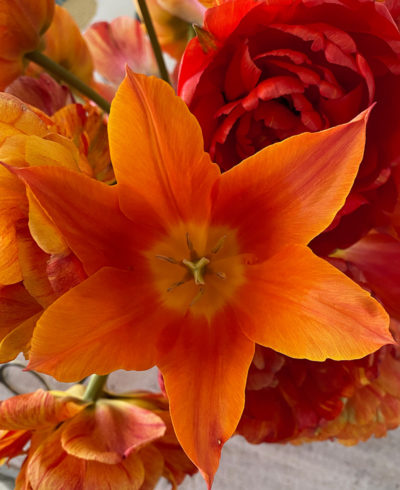
Originally cultivated in the Ottoman Empire (present day Turkey), tulips were a sign of wealth and power. The name tulip comes from the Persian word for turban because sultans would wear them on their turbans as a symbol of strength.
In the late 1590’s, pioneering botanist Carolus Clusius was one of the first in his field to write extensively about the tulip. This intensified their popularity. Because they were rare and incredibly difficult to procure, a “feverish” desperation to obtain them took hold of flower lovers. His personal garden was often looted for its tulip bulbs (now that’s a theft I can get behind!).
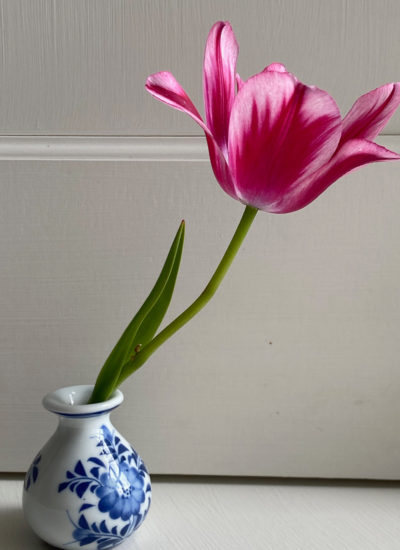
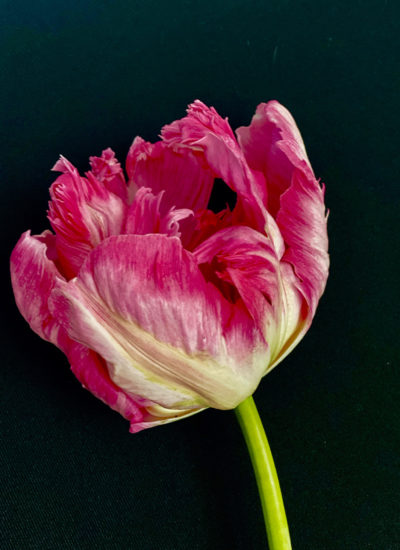
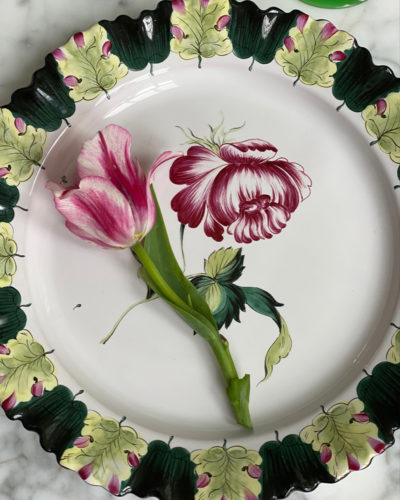
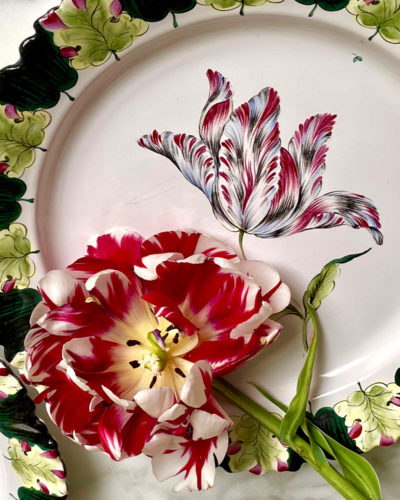
Tulips were brought to the Netherlands in the 16th century. By the 17th century their popularity reached incredible heights. From 1636-1637, the entire Dutch society went mad for tulips (a period appropriately coined “Tulip Mania”). Citizens spent up to a year’s salary to obtain exotic tulips in the hopes that they could be sold for profit. Everyone was in on the hysteria, from noblemen to chimney sweeps. In 1637, the bubble burst, spiraling the Dutch economy into ruin. Modern economists have challenged the veracity of this story and some think it took its place in history because it was just a really “great story” that was embellished. Flowers as currency does make for quite a tale!
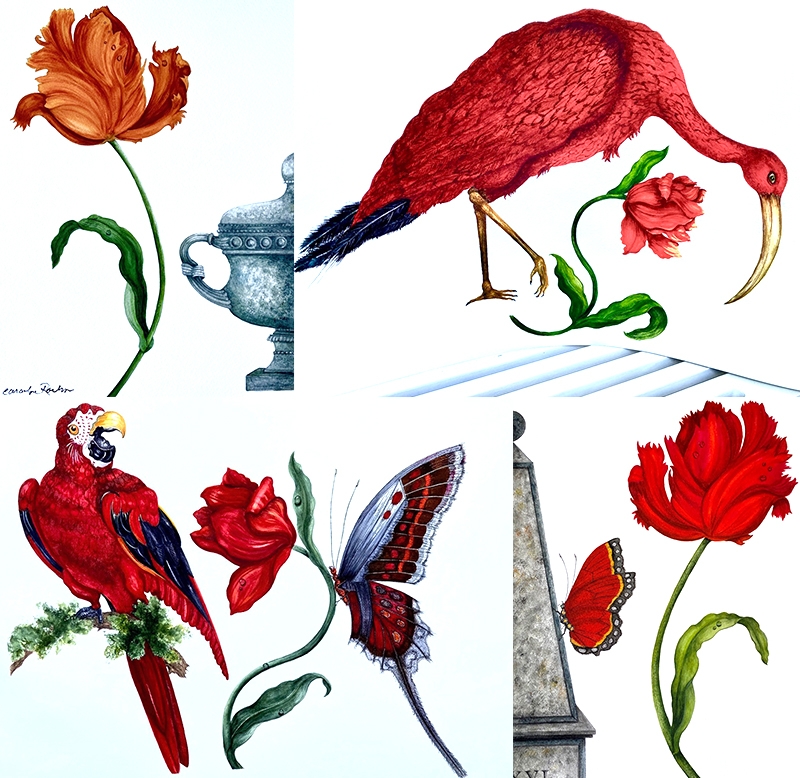
My love of tulips (and birds!) has inspired me to return to them frequently as themes in my paintings and experiment with different pairings of subjects. These are available for sale as high-quality art prints on my website (carolyneroehm.com).
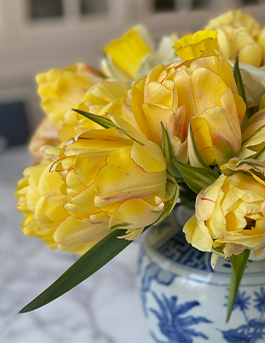
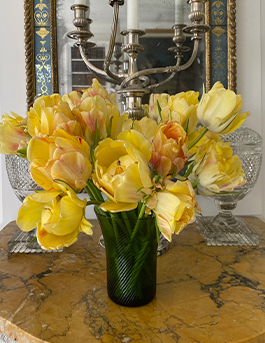
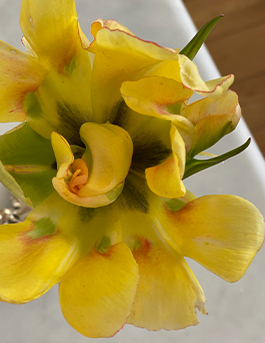
Tulips have taken their place as a beloved flower around the world. They are the subject of countless renowned paintings and people gather every year to celebrate them in festivals across the globe.
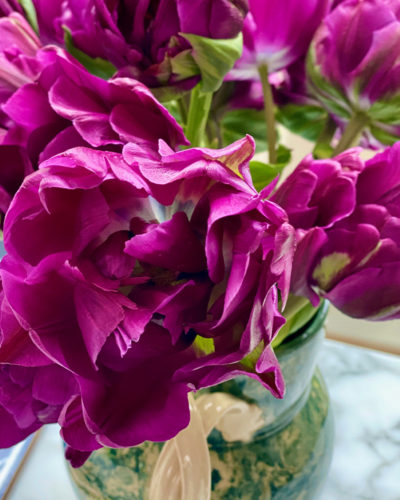
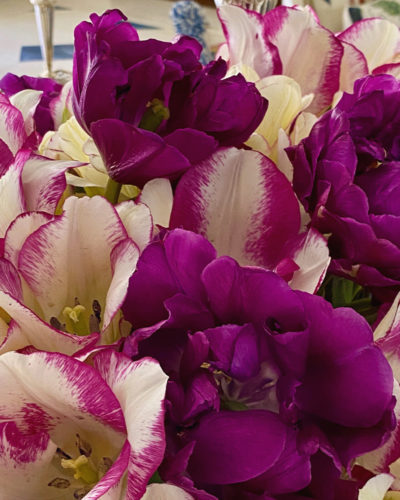
It is Dickens who wrote, “Nature gives to every time and season some beauties of its own; and from morning to night, as from the cradle to the grave, is but a succession of changes so gentle and easy that we can scarcely mark their progress”. So sadly, just like that, it’s time to say goodbye to our beautiful tulips.
But here at Weatherstone, we are anxiously awaiting the peonies next, so stay tuned!
Carolyne
The Flowers Book and Flower Prints are available at the Carolyne Roehm Shop.
Click here to visit the shop.
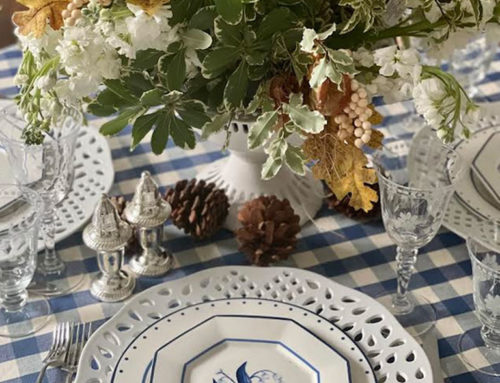
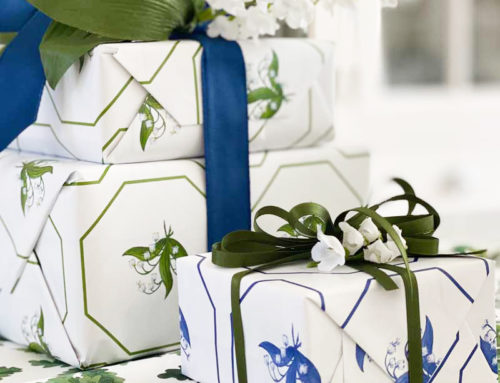
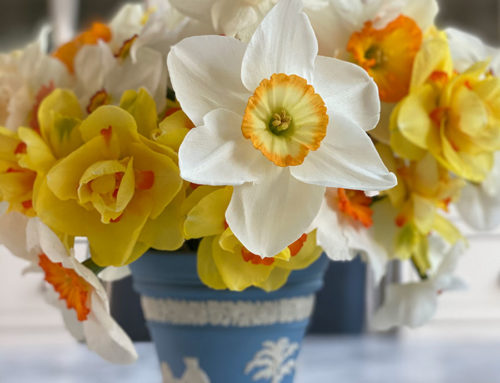


Dear Carolyne,
Undoubtedly, you have been a source of limitless inspiration to me …and of course, to many others. I am writing to you from the Winelands in South Africa – came across your Blog and was smitten. I am the proud owner of two of your books : “A Passion for Blue & White’ and “Design & Style”, which I use constantly for ideas and sensational inspiration. Your colour palette suggestions and interior ideas are a great resource for our Guest House ” The Light House Boutique Suites. You are absolutely fabulous in sharing so much of ‘who you are…….. your amazing creative instinct………and injecting the love of beauty into life. We’re supporting America and the rest of the world, in our thoughts and prayers, during this devastating Covid-19.
Delighted that you’ve overcome your illness and that you unselfishly continue to share your life’s treasures.
Darrol – Your message truly brightened my day so thank you! I think we are all drawing inspiration and strength from each other during this difficult time, so the more creativity we share, the more joy we spread! I hope you are enjoying your amazing location and that you are staying safe and healthy. We are supporting you as well and sending our very best to your beautiful country.
What a beautiful post. You have such an eye for detail. Thank you for all you do. Stay sfe.
Eve – Thank you so much! Hope you are staying safe as well. All the best to you.
You ARE an enigma!! Such beauty you not only portray but, obviously, feel. Just spectacular..CHEERS!! franki
Franki – Cheers to you as well! Sending you strength during this time. Bw safe and be well.
Carolyne – What a lovely thing to wake up to this morning…. this latest post showing even more images than usual and each one more astounding than the one before. Well, really they’re all pretty astounding. I’m finding myself thinking about (and loving) tulips more this year than ever before and I suspect it’s due to your recent posts about this exotic gem. People probably don’t think immediately of the word ‘exotic’ in connection to the tulip but they would if they saw posts like this. I’ve heard you explain something about your ‘process’ – taking a concept from stage to stage – seeing something in nature,.. translating it to your painting… bringing it to table arrangements and so on. This post today illustrates all that and I had much fun reading it and gazing at your gorgeous photographs. Thanks for starting my Friday on an incredibly beautiful note. Be well, Kim
Kim – Thank you so much! When you read the history of tulips, they certainly were exotic and rare in the past, based on the lengths people would go to just to have them! I’m so happy you are enjoying the tulips this year. I think we are all appreciating our time with nature now more than ever. Stay safe!
Tulips and birds! Tulips and birds! Two of my favorite things in the world 🙂
Thank you for the flowers Carolyne – They brightened my day.
Donna – I’m so happy to brighten your day! Stay safe and be well.
Dear Carolyne, This is so stunningly beautiful that I really have no words to describe it so I will just say thank you for all the beauty you bring into our lives. Bless you!
Thank you, Debbie! Hope you are doing well and staying safe.
Dearest Carolyn,
You have no idea the absolute joy and passion you’ve ignited in me! Your exquisite taste in all you touch has provided such inspiration for me to once again resume gardening, rekindled my love of blue and white, and created a new passion for color in my neutral home! Thank you for so joyfully and honestly sharing yourself with all who love to follow you!
Always, Patti
Patti – Thank you so much! I agree – this time needs a spark of color and joy! Sending you my best during this difficult time.
THAT DOES IT!
THAT FIRST PHOTO OF PURPLE AND YELLOW!THAT WILL BECOME MY BEDROOM!I ALREADY HAVE YELLOW WALLS NOW TO ADD MORE PURPLE!
YOU ARE A PRIMA BALLERINA ABSOLUTE in OUR WORLD of BLUE JEANS, SWEAT PANTS and T-SHIRTS!
I LOVE THE BIT HERE:Originally cultivated in the Ottoman Empire (present day Turkey), tulips were a sign of wealth and power. The name tulip comes from the Persian word for turban because sultans would wear them on their turbans as a symbol of strength.
I have started wearing TURBANS as an accessory as the hair is NOT what it ONCE WAS!NOW I WILL ADD A TULIP OR THREE(plant always in odd numbers!)and call it THE CR LOOK!
I ADORE MY BIRD RING……….
I ADORE YOU!
KEEP US GOING as there really is NO one else out there who does it LIKE YOU!
BE WELL……..
XXXX
Thank you – what a joyful response! And do not fret – all our hair is compromised;). Stay safe, happy and well!
Oh Carolyne! Thank you for sharing the gorgeous photos as well as the history of these beautiful flowers. Each Autumn I plant dozens more varieties of tulips and can barely contain my excitement for Spring to arrive and blooms to appear! Next up Peonies!!! Take care!
Teri – I always anticipate the blooming of my tulips! Enjoy your time in your garden. Hope you are staying safe and well!
Lovely photos and lovely flowers–just like you, Carolyne!
Thank you so much!
My first glimpse of tulips was along the walkway to an Episcopal chapel. Red tulips💓 My late mother could hardly believe her eyes! Tulips in Tallahassee Florida. They were her favorite flowers next to Professor Sargent camellias. I still wait anxiously every spring for red tulips at the local grocery.
Carrie – what a wonderful memory and a way to continue to cherish your mom. Hope you are staying safe. Be well and enjoy your weekend!
Your tulips are simply splendid. The fact that the season is short makes them that much more special. It is worth considering as we cope with COVID 19, that the variegated tulips so prized by the Dutch was caused by a mosaic virus transmitted by an aphid. The virus both weakened the plant but produced such magnificent flowers. It is the yin and yang of the circle of life.
Be well.
Karen
Karen – Yes! I had read that and found it both interesting and certainly pertinent. An interesting fact for the times, for sure. Im enjoying all the phases of my garden – more so this year than ever before. It gifts me hard work to look forward to, contentment and comfort. Hope you are finding the things that give you the same. Wishing you continued fortitude as you keep yourself healthy and safe!
Thank you so much for the delightful images and the history of these most beautiful flowers! You truly have a gift in many ways, Carolyne.
Best,
Robin
Thank you, Robin! Hope you are doing well at home and staying safe. Enjoy the rest of your weekend!
Carolyne, I’m just now opening your email and it is a Godsend. After Covid and the riots and looting across America, I am in need of your beautiful tulips and your tables capes and of course your artwork! I am going to post one of these images on Instagram and link to your IG page. The world needs your perspective right now. I hope you continue to stay well. xoxox, Brenda
Brenda – I think we are all in need of a little escape right now. Everyday life has been filled with such strife and suffering for some and the news is just heartbreaking. I needed my tulips this year more than ever as well! Thank you so much for posting my painting. Hope you are safe and well!
I love the blue and white bowl with the red and white tulips ! Beautiful !
Charlie
Thank you! I love blue and white with every color flower! The perfect stage, I say!
I would love to say”if anyone is sad or down all they have to do is look at your gorgeous flowers”and their out look will perk right up.Thank you so much for sharing!!!!
Sherry – Ha! I know that exactly what I do! Nature has a way of shifting our moods and perspectives. It’s become my favorite retreat during this time. “I need to get away” used to mean a trip. But now it’s as simple as stepping outside our homes or going to a park. I think we have all come to appreciate what’s right in front of us! Be well!